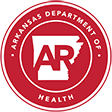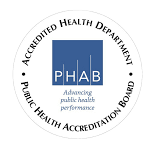Public Health in Arkansas
Keeping Your Hometown Healthy
Preventing disease and disability has been a major concern of the Arkansas Department of Health for a long time. In fact, the roots of public health can be traced back to 1832, when Little Rock's town council created the first city board of health in the Arkansas Territory.
Relatively few Arkansans died when yellow fever ravaged the Mississippi Valley in 1878, yet the epidemic's effects proved to be the catalyst to organize the first official state board of health in 1881 – which died due to lack of funds. When the Legislature moved out of the Old State House to the current capitol building for its first session in 1913, a permanent state board of health was appointed – seven members, all physicians – and moved into the vacated facility on Markham Street. Since that time the Board has regulated and generally provided supervision for all public health activities.
In the beginning, the new board of health focused on eradicating hookworm. A program to improve home and school sanitation was initiated, as well as a program to eliminate malaria through mosquito control. In 1918, Arkansas became the first state to require children to have a compulsory childhood smallpox vaccination in order to attend school. In 1919, the Board began a vigorous educational campaign against venereal disease after thousands of infected Arkansans were unable to join the Army during World War I. By the 1920s, with the assistance of federal and private funds, the Board had instituted inspections of water supplies and mandated sanitary requirements that practically eliminated Typhoid fever. An effective program for improving the health of infants and mothers caused the infant death rate to decline and life expectancy to increase, all before the end of the 1920s.
The Great Depression of the 1930s amplified the health problems of that era. Many people who could no longer afford private medical care turned to public health for assistance. During this time, thousands of immunizations were given to combat typhoid fever, smallpox and diphtheria.
By the late 1930s and into the 1940s, the Department had begun cancer and heart programs, as well as for safe water supplies and malaria control. It also stepped up efforts related to food safety and drug control. During the post-war era, more and more people moved into cities from farms, creating new needs related to city water and sewer services.
Also after World War II, public health centered on incorporating modern technology and conveniences into the existing health care and health protection structure. Many people, however, remained without access to primary health services. The anti-poverty programs of the 1960s directed attention to the needs of the poor. New social programs dictated new directions for public health while making possible the dramatic expansion of public health activities.
Beginning in the first part of the 1960s, Arkansas led the nation in tuberculosis treatment by developing a program that applied new theories about health services planning and implementation as well as the effects of modern medical technology and treatment. Short-term hospital treatment was a startling change from previous methods of treatment. Better diagnosis and new drugs made traditional sanatorium treatment obsolete.
From the mid-1960s the field of public health has experienced profound changes in its goals and structure. Exploration in new roles for public health work go beyond tuberculosis treatment and environmental control to encompass home health, Women, Infants and Children (WIC) programs, maternity and infant care, and youth projects and programs emphasizing prevention and early treatment of medical conditions.
Today's Department of Health
In the 21st Century, our public health services continue to evolve and expand. New or updated programs and services today include:
- Preparation for acts of terrorism, for pandemics and natural disasters
- Emergency health
- Operation of statewide trauma system
- Control of AIDS and other sexually transmitted diseases
- Family planning programs
- Rural health development
- Prevention infectious diseases
- Health improvement for all ages, including women and children
- Improved oral health
- Tobacco prevention and cessation
- Assuring safe medical and emergency facilities
- Injury prevention
- Pharmacy services and drug control
- Food and water safety
- In-home nursing services to permit independent living
- Surveillance, tracking and measuring trends of diseases
- Collecting, analyzing and utilizing health information data
- Public health laboratory services
- Community-based local public health services and initiatives
Board of Health Today
In 1971, an extensive reorganization of government in Arkansas changed the duties of the Board of Health. Many of the powers that existed within the Board were transferred to the Department of Health, which became a cabinet level agency in the executive branch of government responsible for implementing the Board’s regulations. The Board retained four very important responsibilities:
- Advisory capacity to assist in the development of public health policy;
- Power to adopt rules and regulations and serve as the administrative tribunal for enforcement of these rules and regulations;
- Power to nominate a director of the Department; and
- Pursuant to the by-laws of the Board, act as advocates for the Department and all Arkansas residents, particularly those whose health is at greatest risk.
Today’s Board is comprised of 24 members, including eight medical doctors. As we look forward to the challenges of the future in public health, the Board remains a vitally important partner and will remain an essential element in any reform or change in the health delivery system in the state.
*A source for much of the information above was “The Pain in Prevention, A History of Public Health in Arkansas” written by Sarah Hudson Scholle for the Arkansas Department of Health, copyright 1990.


